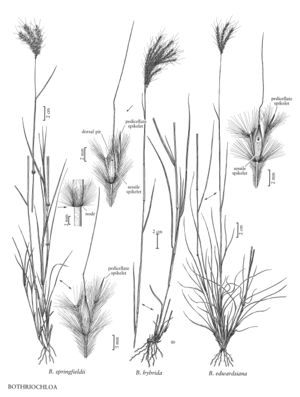Difference between revisions of "Bothriochloa edwardsiana"
FNA>Volume Importer |
imported>Volume Importer |
||
| Line 39: | Line 39: | ||
|publication year= | |publication year= | ||
|special status= | |special status= | ||
| − | |source xml=https:// | + | |source xml=https://bibilujan@bitbucket.org/aafc-mbb/fna-data-curation.git/src/bb6b7e3a7de7d3b7888a1ad48c7fd8f5c722d8d6/coarse_grained_fna_xml/V25/V25_1561.xml |
|subfamily=Poaceae subfam. Panicoideae | |subfamily=Poaceae subfam. Panicoideae | ||
|tribe=Poaceae tribe Andropogoneae | |tribe=Poaceae tribe Andropogoneae | ||
Revision as of 22:02, 27 May 2020
Culms 35-65 cm, slender, stiffly erect, rarely geniculate; lower nodes shortly hairy, hairs shorter than 3 mm, usually off-white and ascending; upper nodes glabrous or glabrate. Leaves mostly basal, glaucous; ligules 1-1.5 mm; blades 10-25 cm long, 1-2(3.5) mm wide, flat to rolled, with 3-7 mm hairs below the middle. Panicles 6-12 cm, loose, fan-shaped; rachises shorter than 5 cm, with 3-6 branches; branches longer than the rachises, not rebranched, with 1 rame; rame internodes with 3-5 mm marginal hairs. Sessile spikelets 5-8 mm, lanceolate; lower glumes 5.5-7 mm, glabrous, shiny, with a deep dorsal pit, tapering to a narrow, slightly bifid apex; awns 20-28 mm; anthers 0.5-1 mm. Pedicellate spikelets 2.5-3.5 mm, sterile. 2n = 60.
Discussion
Bothriochloa edwardsiana grows in the rocky plains and prairies of the Edwards Plateau of Texas, on calcareous soil, at 300-600 m. It also grows in northern Mexico and Uruguay. It resembles B. hybrida in some respects, but that species has a more robust habit, predominantly cauline foliage, and wider leaf blades.
Selected References
None.
